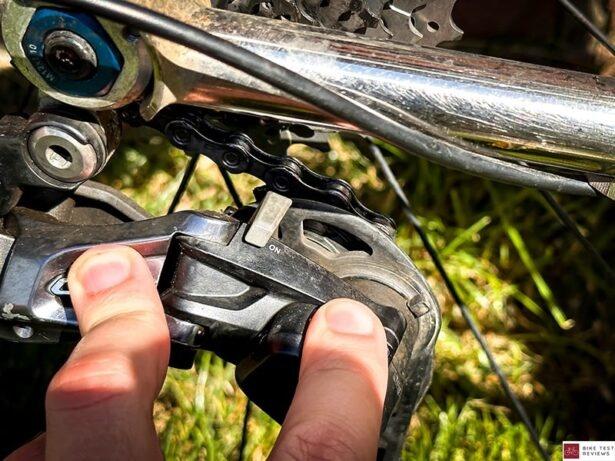We have seen a lot of new technology in recent years in cycling. You can now get electronic groupsets, suspension which is built into the frame, and even flip chip forks, giving you the ability to adjust the bike geometry on the go.
One new piece of technology we are getting asked many questions about is the clutch derailleur. This actually has been around much longer than you might think and is an incredible bit of kit for off-road riding.
In this article, we’re going to tell you everything you need to know about the clutch derailleur by discussing the following:
- What Is A Clutch Derailleur?
- Clutch Derailleur Pros And Cons
- Do I Need A Clutch Derailleur?
What Is A Clutch Derailleur?
A clutch derailleur is a type of derailleur that is used on off-road bikes. It’s designed for off-road riding and is commonly seen on mountain and gravel bikes. They are very common on 1X gearing systems and excellent at handling rugged terrain.
What Is A Derailleur?
Let’s start with the basics, what is a Derailleur? A derailleur is designed to shift the chain around the gears on either the cassette or the chainrings. Bikes come with either just a rear derailleur on a 1X system or a rear and front derailleur on a 2X or 3X system.
What Does The Clutch Mean?
Where does the clutch come into the equitation? Well, the clutch in a clutch derailleur is a small mechanism that creates friction in the system. This means there’s much more resistance through the derailleurs movement.
The extra resistance provides a lot more stability across the system and, when riding off-road, makes it much more stable and the gearing much more efficient and easier to control.
The clutch can typically be switched on and off by either a small switch on the derailleur itself or some work remotely on the shifter paired to the derailleur.
It is worth mentioning the gearing is less smooth with the clutch on. Many gravel riders have the clutch off on the road, and when they hit a rough trail, they switch it on.
The Purpose Of A Clutch Derailleur
So the purpose of a clutch derailleur is to keep the gearing silky smooth no matter if you are on the road or on a rough trail. They are very handy to have for mixed terrain riders and also can really improve the experience of riding your bike.
Clutch Derailleur Pros And Cons
A clutch derailleur does come with some great advantages, but there are also disadvantages. Here’s what you need to know:
Clutch Derailleur Pros
Adjustable Tension
The first thing to mention is adjustable tension. By turning the clutch on, you are able to tighten the tension to give yourself a better experience riding off-road in very rough conditions. Although it does not sound like it will make a big difference, this ability goes a long way.
Reduced Chain Drop
Another great feature of a clutch derailleur is the fact they are able to retain the chain much better compared to a non clutch derailleur. The extra tension forces the chain to move much less erratically, keeping it on cassette and chainrings.
Reduced Noise
Clutch Derailleurs are also excellent at reducing the noise of a derailleur on a trail. With less movement, you get much less chain slap, less flex on the derailleur chain cage, and a lot less knocking.
Clutch Derailleur Cons
Increased Weight
Clutch derailleurs are heavier compared to a standard rear derailleur. Although it’s not by much for some riders, weight does really matter to professionals. You’re looking at roughly 50 grams extra, which is nothing for a recreational cyclist.
Price
You will also find that clutch derailleurs do cost a little more than a standard derailleur. With more technology and a slightly more complex building process with the manufacturer, they cost about 20% more.
Harasher Shifting
When it comes to using the clutch function on a rear derailleur, you will find that the shifting is rougher. It still works fine, but on mechanical systems, it just feels like harder work, but when it’s turned off, it’s normal again.
Do I Need A Clutch Derailleur?
A clutch derailleur is a great function to have on your bike, but it isn’t always required, in our opinion. Here are the two cases we highly recommend having a clutch derailleur.
Off-Road Riding
Riding off-road can be a very fun experience. On off-road trails, which will shake you around, then a clutch derailleur can help your performance and limit the number of times your chain takes itself off.
I highly recommend having a clutch derailleur when it comes to off-road riding. It’s where they work best, and you can hugely notice the difference between riding with the clutch on compared to with the clutch off.
1X Gearing
Another situation we highly recommend a clutch derailleur is on a 1X system. When it comes to a 1X, you typically use a larger rear cassette and a small front chainring. With this setup, the chain has to move around a lot more than a 2X or a 3X system.
A clutch derailleur makes it much easier to keep the chain under control and does hold the whole system in place much better. Although you don’t need a clutch derailleur on a 1X system, it works much better with one.
A Final Note
Clutch derailleur systems have got really big in the past couple of years, and they definitely have a place when it comes to off-road riding and on 1X systems. We highly recommend getting one, and it’s a great upgrade to make to a budget gravel bike.
Read next:
- What Is Derailleur Guard & Should You Have It?
- Best Derailleur Hanger Alignment Tools
- Best Mountain Bike Derailleurs

Robbie Ferri has spent years working in a bike shop, has worked with industry leading brands on product creation, has been a semi pro athlete, and is a fully qualified strength and conditioning coach. He has broken World Records, bikepacked all over the World and raced ultra distance at a top-level.






